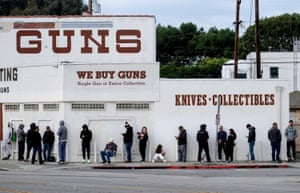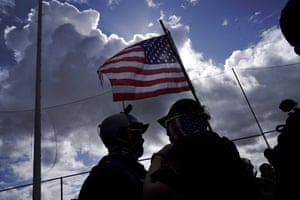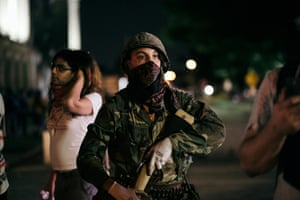In the final minutes of last week’s televised presidential debate, a few days before he tested positive for Covid-19, Donald Trump was asked by the moderator, Chris Wallace, whether he would call on his supporters to stay calm and desist from civil unrest in the immediate aftermath of next month’s election.
Trump pointedly declined the invitation. Instead, he replied: “I’m urging my supporters to go into the polls and watch very carefully, because that’s what has to happen. I’m urging them to do it.”
For those who monitor the activities of far-right militia groups and white-supremacist paramilitaries, Trump’s remarks were as welcome as jet fuel being used to quell a wildfire. Indeed, since they were made the FBI launched a series of arrests of militia members and others plotting to kidnap the Michigan governor, Gretchen Whitmer, and attack law enforcement, adding to a sense of a nation spiraling out of control as November’s election approaches.
“The militias will absolutely seize on [Trump’s comments],” said Steven Gardiner, who tracks militias at the progressive thinktank Political Research Associates. “The possibility of armed factions with military-style rifles showing up at polling places is very troubling.”
Devin Burghart, the director of the anti-bigotry organization the Institute for Research and Education on Human Rights, had a similar sinking sensation when he heard Trump’s words. “My first thought was ‘Here we go’. This is the stuff of our worst nightmares.”
The US president’s clarion call to his supporters to intervene at polling places on election day comes at a perilous moment. As the country is battered by the combined winds of the pandemic and Trump’s personal battle against the virus, the Black Lives Matter reckoning over racial injustice, and the pending turbulent election, the US is not only more virulently divided than at any time in decades, it is also more heavily armed.
FBI background checks – a direct indicator of gun sales – almost doubled year-on-year this summer, a reflection of the jitters that abound. As America arms itself, deadly weaponry is increasingly finding its way on to the streets, borne by self-styled private militias and culminating in violent clashes that have caused bloodshed in several US cities.
People wait in a line to enter a gun store in Culver City, California. Photograph: Ringo HW Chiu/AP
With the most ferociously-contested presidential election in modern times now less than a month away, there are signs that heavily-armed militia groups, many of them finely attuned to Trump’s every whim, are setting their sights on the ballot.
“A number of groups have begun talking about mobilizations on election day and beyond. We’re hearing initial chatter about preparations for 3 November and we’re paying close attention,” Burghart said.
Burghart’s research group has been tracking the escalation of militia activity especially in key swing states. In Pennsylvania, Michigan and Wisconsin in particular, groups have been detected discussing what they call “voter integrity” efforts on polling day.
“We anticipate that after Trump’s call to arms at last week’s debate we’ll see a lot more activity from here,” Burghart said.
In Montana, a popular base for libertarians and militia members, there are similar signs of militia groups assiduously retweeting Trump’s falsehoods about mail-in voting fraud, circulating the lies widely among themselves.
In the closed social media groups and chatrooms where more detailed conversations can be held away from public oversight, far-right ideologues are going several steps further than merely repeating Trump’s conspiracy theories. They are attaching them to familiar antisemitic and racist tropes.
One popular line in Montana is that the billionaire philanthropist George Soros, who is Jewish, is using his fortune to encourage liberal voters to cast their ballots multiple times.
Rachel Carroll Rivas, the co-director of the Montana Human Rights Network, which monitors extremist networks in the state, said they were picking up intensifying conversation among militia groups about the legitimacy of the 3 November ballot and of the integrity of mail-in voting. “This really is top down – they are repeating word for word what they hear from President Trump.”
In addition to the Soros lie, Rivas said, militia groups such as the Montana branch of the United States Freedom Protectors were positioning themselves to be vigilante outriders of law enforcement on election day. Though their planning is as yet relatively unformed, Rivas said, the possibility of interventions by armed members of the group had to be taken seriously.
“They present themselves as protectors of property and law and order, and are now starting to talk about the election. They may show up at polling places claiming to want to protect voting rights, but their impact will clearly be intimidatory,” she said.
Putting a figure on the scale of the threat posed by extremist militia groups in the US is fraught given their secretive communications online. The New York Times has estimated there are up to 20,000 active militia members in about 300 groups, with a quarter consisting of military veterans.
A member of the Proud Boys, right, tries to get a counter-protester to leave a Proud Boys rally in Portland in September. Photograph: John Locher/AP
The pool of Americans with some militia engagement might extend much wider than that. An investigation by the Atlantic into the Oath Keepers, one of the most prominent groups, revealed a leaked database of almost 25,000 current or past members, two-thirds of whom were from military or law enforcement backgrounds.
Whatever the numbers, white-supremacist militia groups in America have grown in recent years to the point where they pose the prime domestic terrorism threat, even while the Trump administration has tried to play down the danger. Earlier this month a whistleblower complained that officials of the Department of Homeland Security had been instructed by superiors to alter intelligence reports to make the peril appear less severe.
It’s even harder to put a figure on how much Trump has emboldened the militia, though the encouragement he has given is beyond doubt. Not only has he consistently refused to condemn the groups, as he did with the Proud Boys at last week’s TV debate, but he has maintained a steady dialogue with them through social media.
“The relationship between the militias and the current administration is call and response – it’s not always clear who’s leading the chant. Sometimes it’s coming from the militias, sometimes it’s coming from the president,” Gardiner said.
It’s not just the rightwing paramilitaries that pose a mounting danger. Anti-fascist and radical left groups have shown a growing recourse to guns too, as was seen with the shooting by a self-styled anti-fascist activist, later himself killed by police, of a member of the pro-Trump group Patriot Prayer in Portland last month.
African American armed militia activity is also back to a level of open defiance that hasn’t been seen since the “cop-watching patrols” of the Black Panthers in the 1970s. The NFAC (Not Fucking Around Coalition) has staged several actions by its military veteran members, dressed all in black and wielding semi-automatic rifles.
On 4 July the coalition staged a parade of about 1,000 NFAC “troops” in Stone Mountain, Georgia, the birthplace of the modern Ku Klux Klan. The group’s leader, Grand Master Jay, told Channel 4 News this month that the goal of the militia was “the protection of the black race, the policing of the black race, the education of weapons of the black race”.
The arming of African American and anti-fascist factions has contributed to the volatility of the times. But the overwhelming bulk of militia activity falls firmly on the other side of the country’s widening racial divide – with the overwhelmingly white far-right.
The summer saw the proliferation of incidents across the states of far-right militia groups confronting Black Lives Matter protesters. Gardiner’s team at Political Research Associates has carried out as yet unpublished research that records almost 600 such appearances of small but frighteningly well-armed bands of Trump supporters and far-right extremists.
A troubling aspect of Gardiner’s findings is that since the late summer there has been a gradual rise in militia events ending in violence. “The number of serious incidents of outright violence, shootings, vehicular assaults or menacing with a pointed gun is on the up,” he said.
An even more sobering observation is that by far the largest subset of these militia events, comprising at least 40% of the almost 600 recorded total, were uncoordinated, with no known involvement of the Oath Keepers, Three Percenters, Proud Boys, or any other established group.
That means that there have been almost 240 incidents where small and entirely leaderless bands of extremists coalesced online and then proceeded to take their armed fantasies on to the streets of America. One expert on domestic terrorism has likened the phenomenon to “online flash mobs”.
Take the chain of events that led up to the tragic loss of life in Kenosha, Wisconsin, on 25 August. Two days previously, protests broke out in the city after a video captured Jacob Blake, an African American man, being shot in the back and paralyzed by a police officer.
On the night of 25 August, several armed individuals formed themselves into a militia on the streets of Kenosha to act as a vigilante counter-point to the anti-police brutality demonstrators whom they denounced as leftist “thugs”. The unrest culminated with a 17-year-old member of the group, Kyle Rittenhouse, allegedly shooting at protesters, killing two and injuring a third.
An investigation by the Atlantic Council’s digital forensic research lab traced the gelling of the militia back to its online roots. They discovered that 13 hours before the shootings a notice calling on people to gather on the streets of Kenosha was placed on the existing Facebook page of a local militia calling itself the “Kenosha Guard”.
A second invitation to assemble was put out via a separate Facebook group that popped up that same day having been created by an individual with no known militia affiliation. He called the page, “STAND UP KENOSHA!!!! TONIGHT WE COME TOGETHER”.
Significantly, it was the spontaneous and impromptu group, Stand Up Kenosha, and not the already established Kenosha Guard militia, that appeared to have the greatest impact – both in terms of the virulence of the violent threats that it posted on Facebook and in the responses it received.
A so-called militia man shows up on the protester side and offers armed escorts to a safe position in Kenosha, Wisconsin in August. Photograph: Jim Vondruska
Andy Carvin, a senior fellow at Atlantic Council, said that the finding was surprising, and disturbing. “Stand Up Kenosha played a much more dangerous and potentially volatile role that could have led to even more violence. This is the stuff that now keeps me up at night: these spontaneous groups that have found a way of attracting individuals who have no prior militia affiliations of any sort.”
The paradox is that under both federal and state laws, militias should have long ago been prohibited. Mary McCord, the legal director of the Institute for Constitutional Advocacy and Protection, said that the legal status of the groups is crystal clear – they are unlawful.
“There is nothing in the law that allows private individuals to self-deploy and engage in military or law enforcement-type activities,” she said.
At a federal level, US supreme court rulings in 1886 and 2008 have unambiguously stated that the second amendment right to bear arms is irrelevant when it comes to banning private paramilitary organizations. At state level, all 50 states have provisions in their constitutions or in statute that outlaw militia activity unless it is at the express orders of the governor.
“This is actually not a grey area at all, you rarely have laws that are so definitive,” McCord said. “It is only because of a lack of understanding that these militias even exist.”
In the final weeks of the election, McCord and her colleagues have been scrambling to distribute fact sheets to all states that point to the laws prohibiting private militias and advise what to do should armed groups turn up at polling places. She is hoping to arm local law enforcement and voters with legal information so that they can push back on extremists armed with AK-47 style weapons.
It’s a daunting task, made none the easier by Trump. “When he talks about ‘poll watching’ and fraud, and refuses to urge his followers not to engage in civil unrest, that’s a thinly-veiled dog-whistle for armed groups to coalesce.”





Spread the word